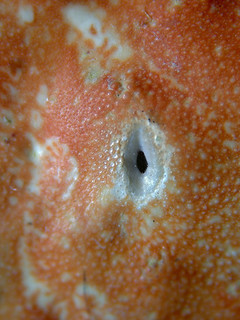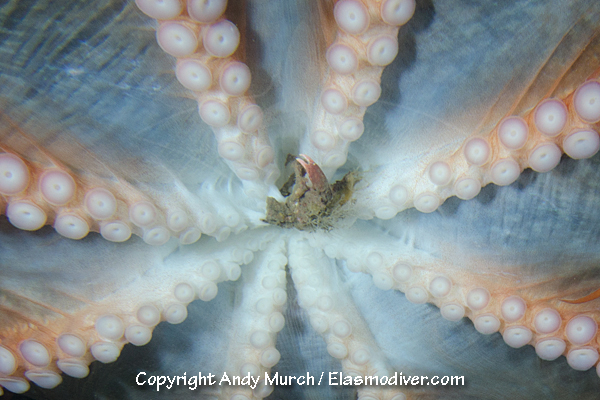What's for Dinner?
The giant Pacific
octopus is heterotrophic carnivore. The octopus feeds upon a wide variety of
sea creatures. Snails, shellfish, clams,
crabs, scallops,
lobsters
and
shrimp are among the more common octopus meals. They have also
been known to feed on birds, sharks, and small fish.
Enteroctopus dofleini uses many of its
adaptations to capture prey. The
octopus’s siphon is used to uncover shelled prey on the ocean
floor. Water is ejected from the siphon to blow away sand and
gravel, which leaves food sources exposed for consumption. The
suckers on each of its eight arms are used to hold on to the prey.
Suckers are also very sensitive and individually experience touch and taste sensations.
Each arm is very strong. The octopus uses them, combined with the
suckers, to pry the prey’s shells apart or to snatch and hold the
creature in place. Since octopuses frequently feed during the night,
they frequently use these features to feel along the ocean floor for
their prey. The arms also transfer the food up to the octopus's
mouth.


The Pacific octopus uses its horny beak to crack and crush the shells,
or exoskeletons, of some of its food sources. Shells can be found with a
small hole drilled in them. (See photos above.) The octopus creates
these holes using its salivary papilla,
a drill-like mouth structure, to bore into the bivalve’s inner cavity.
After the hole is drilled, the octopus then pushes saliva, which
contains venom, into the shell. This venom further corrodes the shell
and weakens the prey. The octopus's tongue-like radula
is also used to scrape up food morsels.
To capture the more difficult animals, the octopus uses its most
important adaptation: its intelligence. The giant Pacific octopus
will hide under a rock and use its
chromatophores to blend in to the surroundings. It will then patiently wait for its prey.
When a creature passes by, it will reach out a strong arm
and snatch up the creature, dead in its tracks. This is the
technique the octopus uses to attack a large dogfish shark in this
video. Some octopuses have
also been
seen hiding near docks and capturing birds as they fly past.
After it has captured its prey, the octopus will usually take
it back to its den to consume it. This is why many dens have piles
of empty shells littered about outside of the entrance.

Back to Habitat Forward to Adaptations